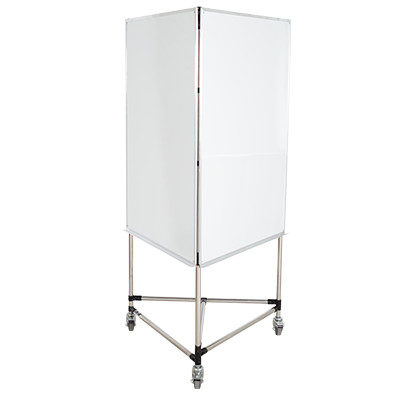
Structure
CARTS
Structure
WORKSTATIONS
Structure
RACKSShowing key performance indicators (KPIs) on boards throughout your facility is one of the best things you can do to improve departmental cooperation and operations coordination. It also helps foster employee motivation and give prominence to your business goals. Modular boards are a perfect way to make sure those KPIs are visible where they need to be. Why? Because you can create movable structures with the desired number of boards, according to the size you need.
Read on to find out which are the 6 most common types of boards used by our customers, and us!
Your employees should feel they play an important role in the company’s success in addition to being mindful of the results and goals of your organization. Wanting to put a man on the moon way back in the 60s certainly illustrates this point. On May 25, 1961, President John F. Kennedy delivered a rousing speech before a joint session of Congress challenging all Americans to send a man on the moon before the end of that decade. He exhorted the audience to believe in, and stand behind, the project stating that every worker’s contribution is valued, regardless of the form it may take. During a visit to the NASA Space Center in 1962, the President noticed a janitor carrying a broom. He interrupted his tour, walked over to the man and said,
“Hi, I’m Jack Kennedy. What are you doing?”
“Well”, Mr. President, the janitor responded, “I’m helping put a man on the moon”.
That janitor had clearly taken President Kennedy’s message to heart.
Innovation goes hand in hand with creating a work environment where everyone feels valued for their input. Using the feedback your employees give you to custom-make user-friendly equipment will ultimately make reaching your goals much easier.
Managing through visual cues benefits workers, new employees learning the ropes, as well as clients touring the plant. When you arrive in a factory, and you can see the process, the objectives and the actual results, explaining and motivation become much easier.
As a side note, if you are considering whether your board should be stationary or mobile, we suggest the latter option as it provides increased flexibility. As an example: let’s say the meeting you are about to attend changes location unexpectedly; all you need to do is simply wheel the board – and the information on it – over to the new meeting spot.

Point-of-use is a sub-concept of 5S techniques. Within the context of boards, this relates to the practice of creating a storage space tailored specifically to each item. These objects may consist of KPI reports, tools, parts, or even maintenance equipment.
Defining an item’s particular location is done with a single purpose in mind: to lessen the number of errors. When tools are correctly displayed and always in sight, training new employees becomes much easier, and the results can be quite amazing! These boards make sure everything has a place, and you ensure everyone knows where everything is.
The guiding principle stays the same, but the boards’ structure can vary depending on what you need to place on them. A modular solution, therefore, provides the adaptability so you can create boards that take up just the right amount of space.
Rotating cubes are unique in that they comprise of four reversible boards, thus giving you a total of 8 surfaces. Each board pivots on its axle so you can easily access its flip side. The major advantage of this type of structure is that is a space-saver. This configuration gives you twice the board surface for half the necessary floor space. It is especially useful as a central unit or in a location with limited room to display valuable information.
Bear in mind that 8-faced boards are trickier to build than other board structures. Make sure to have the building experience or the help of a Flexpipe expert when starting the design of structures like this.

Meetings should never be reserved solely for conference rooms or offices. Meeting space boards let you quickly organize a meeting where and when you need to. Having this type of board on hand lets you easily display instructions and relay messages. If space is limited, you can create a foldable 3-panel hinged board, which is ideal for daily morning meetings, for example.

The next 3 types of boards are multi-purpose structures. The difference is that they are built to support one or more boards on multiple sides. The advantage of using a modular system is that you can create a custom structure that will fit any size of board or panel that you have.

Three-sided boards provide additional space where you can post, for instance, information by category, deadline, objective, etc., all in one compact, space-saving location.

A 4-sided board is a derivative of the 1, 2 and 3-sided boards.